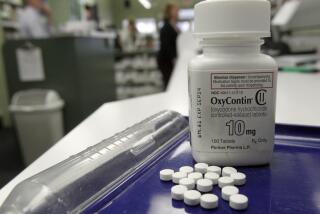Self-Injected Painkillers Due Out Within 5 Years
- Share via
PALO ALTO — Cancer victims and surgical patients may be allowed to administer their own painkillers within five years, said Dr. Paul White of Stanford University Medical Center.
White, an assistant professor of anesthesia at Stanford, said three years of clinical trials show that the Patient-Controlled Analgesia (PCA) devices are successful.
“In trials with about 250 patients, we’ve only had two minor problems resulting from the patients not clearly understanding how to use the PCA,” he said.
One of the patients under-utilized the device because she had difficulty adjusting to the idea that she was responsible for administering the medication, White said. The other patient had lowered blood pressure as a result of the excessive use of the device.
‘Easily Rectified’
“Because the patients still are closely monitored by nurses, those problems were easily rectified,” he said.
With the device, patients administer small doses of painkiller as needed. At their bedside is a button at the end of a cord, which is attached to the machine.
By pressing the button, a small amount of analgesic is injected into an intravenous tubing that sends the pain reliever directly into the bloodstream.
A timer built into the computer-programmed machine deactivates the device for a period of five to 15 minutes after the pain medication is administered to ensure that patients do not inadvertently over-medicate themselves.
With conventional analgesia administered by nurses, the usual time interval between injections is four hours.
‘Become Mobile Sooner’
“Because the patient isn’t as groggy as with nurse-administered injections, most surgical patients are able to get up and become mobile sooner using the PCA,” White said.
“Also, we’ve found that most patients used less medication with the PCA. And, because the patients are taking responsibility for their own care, there’s a real psychological benefit,” he said.
The machines became commercially available last year, White said. Each unit costs between $1,500 and $3,000, but some community hospitals are leasing the devices for about $80 a month.
White said that there are four commercially available devices for hospital use and that others are being developed for use inside and outside the hospital environment.
More to Read
Sign up for Essential California
The most important California stories and recommendations in your inbox every morning.
You may occasionally receive promotional content from the Los Angeles Times.













